The Number of Coffee Types Worldwide
If someone asks you to name a type of coffee and how to prepare it, would you? Probably, maybe not. While coffee is the third most consumed drink in the world, most coffee lovers are often unable to tell the differences when presented with a variety.
You may be familiar with your traditional style of coffee; however, learning a new technique can be helpful since many options are available. Let’s get started.
Name a Type of Coffee – a Complete List
Sometimes it’s difficult to choose from the endless list of coffee beverages available on most café menus. In this section, we’ve compiled a list of some of the different types of coffee drinks you are likely to come across in your favorite coffee shop.
Espresso
Espresso is one of the strongest types of coffee served in a demitasse (Italian for “pressed out”).
Usually, an espresso machine makes an espresso drink. It applies about nine bars of pressure to a compact puck of coffee while forcing water at a temperature of about 205° Fahrenheit (96° Celsius) through it.
Typically, the coffee-to-water ratio ranges from 1:2 to 1:2.5. As a result, the coffee has a lot of body and texture and is extremely powerful. Because of its strong flavor, espresso is mostly the foundation for milk-based beverages.
The drink comes in single or double shots. A standard espresso shot includes 0.2 to 0.3 ounces (7 to 9 grams) of coffee, and the finished beverage has 0.5 to 0.8 ounces (14 to 23 grams) of liquid coffee.
A standard double espresso shot includes 0.5 to 0.6 ounces (14 to 18 grams) of coffee, and the finished beverage has 1 to 1.6 ounces (28 to 45 grams) of liquid coffee.
French Press (Cafetière).
Depending on your age, your grandparents (or maybe great grandparents) most likely used a French press to prepare their coffee. You fill a glass or metal beaker used in the French press with coarse coffee grinds and boiling water.
Pour Boiling water into the brewer with medium to coarsely ground coffee for about 4 to 15 minutes.
A lid with a mesh filter then filters the coffee inside the maker. As a result of the natural coffee oils going through the mesh filter, the final product has a lot of body. Because the drink bypassed the filter, the little coffee ground sediment has a hefty mouthfeel.
A normal French press brew ratio is 1:13 (2.6 ounces (75 grams) of coffee per 33.8 fluid ounces (a liter) of water).
Americano
Americano is a Spanish-American native type of coffee. A single or double shot of espresso serves as the basis for a traditional Americano coffee.
Then, add fresh hot water to the espresso to dilute it depending on personal preference; usually, you may add between 1 to 10 fluid ounces (0.03 to 0.3 liters) of water. The finished beverage tastes somewhat different from filter coffee but is very similar in body.
Turkish Brew
Turkish coffee, a popular coffee beverage in the Middle East, is traditionally boiled on the stovetop in a unique, wide-bottomed coffee pot known as a “cezve.”
Boiling water and powdery-fine coffee grounds create the frothy foam that distinguishes Turkish coffee. This coffee is for individuals who enjoy robust, black coffee.
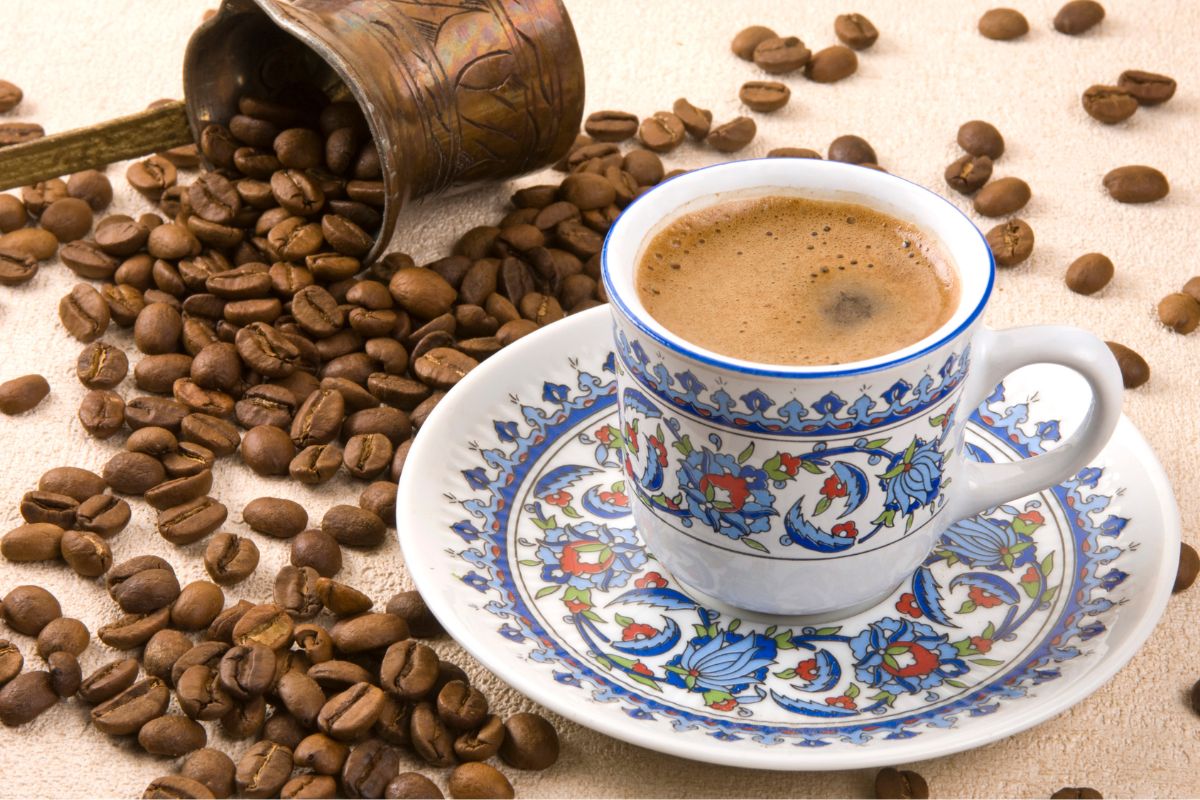
Moka Pot Coffee
The Moka pot, an Italian invention from the 1930s, is a stovetop or electric pot that makes coffee by forcing pressurized steam through ground coffee.
Bialetti produces great Moka pots in 5 sizes (1, 3, 6, 9, and 12 cup capacity). The Moka pot is the ideal alternative to an espresso maker if you are on a tight budget.
Latte
Another well-known coffee beverage from Italy is a latte, which means “milk” in Italian. It normally consists of steaming milk and one espresso shot.
Once more, the drink differs from establishment to establishment. The barista’s ignorance of the distinctions between the milk-based beverages is the primary cause of the variation. Most places serve the same drink as cappuccino, latte, and flat white.
Some specialty coffee shops make latte art using a latte. The barista adds a variety of designs using steamed milk and espresso crema, such as a rosetta or heart.
Cappuccino (Cappuccino Latte)
One of the most widely recognizable beverages in the world is the cappuccino or “capuchin” in Italian. The typical ingredients are one shot of espresso, a layer of steamed milk, and a layer of foam on top. One may occasionally sprinkle chopped chocolate on top.
Cappuccino holds the Italian coffee culture so deeply. It is only drunk in Italy until roughly 10 am at breakfast.
Depending on the location or region, cappuccinos‘ quality differs greatly—for instance, the French use Chantilly cream as the final garnish rather than steamed milk foam.
It’s interesting to note that an Italian monk Capuchin gave the name cappuccino rather than the word for “hood” in Italian. The beverage bears the name cappuccino because it resembles the robes worn by Capuchin monks in terms of color.
Iced Coffee
Cold brew is best if you want the ideal, smooth cup of coffee. For a lengthy time, say between 12 and 24 hours, coarse coffee grounds steeped in chilled water create a cold brew called iced coffee.
A French press, an airtight cold brew maker, or a mason jar is all you need to make a cold brew at home. It is famous for having a powerful, rich flavor without any bitterness.
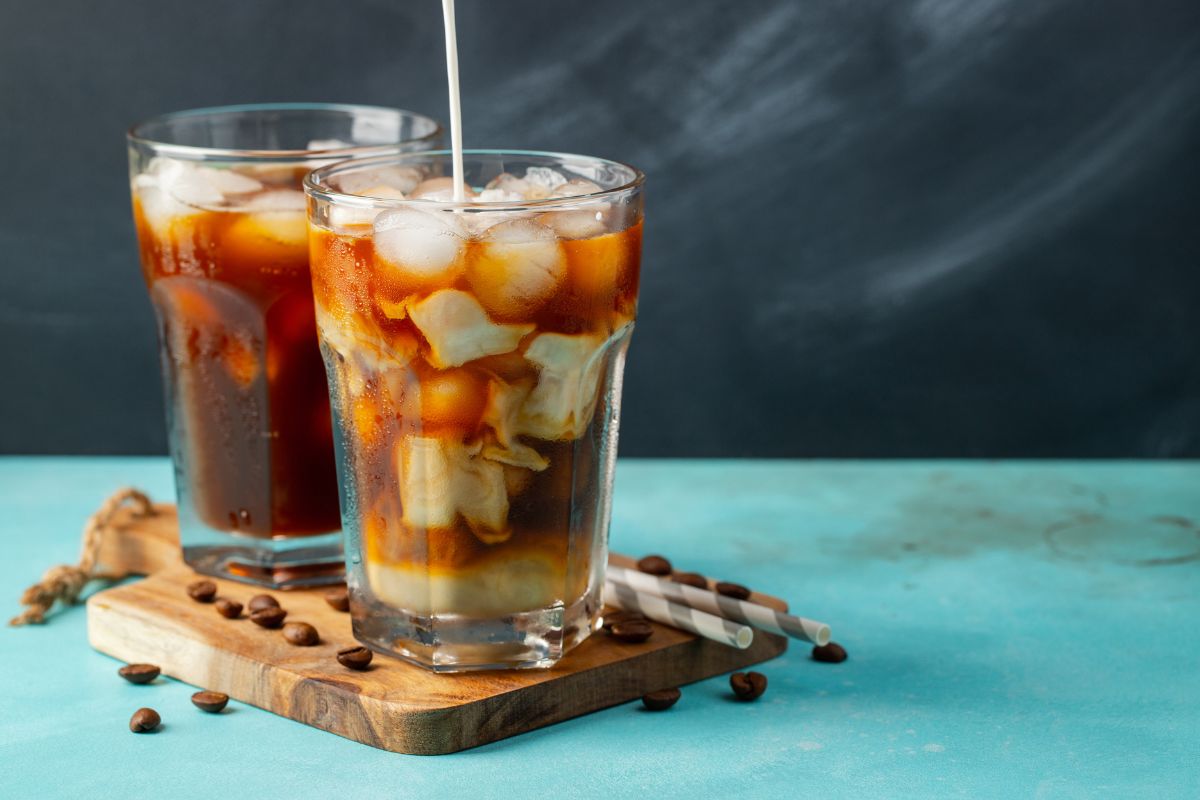
Flat White
When it comes to milk-based coffee drinks, the flat white is the new kid on the block. It is native to both Australia and New Zealand. Usually, a combination of steamed milk and a double espresso makes a flat white.
The flat white is comparable to a latte but typically costs a little more because there is more coffee. Some specialty coffee shops decorate flat white coffee with latte art.
Cowboy Coffee (Boiled)
The traditional cowboy method will at least save you from going through coffee withdrawal if your coffee machine breaks down unexpectedly or if you want coffee while camping outdoors.
Boil fresh water in a pot while adding coffee grounds. You can then pour the coffee into a mug and sip it once the ground coffee has settled to the bottom of the pan.
Pour Over Coffee
A tried-and-true method for preparing coffee is the pour-over. Simply pour hot water through a cone or higher chamber into coffee grinds in a filter.
It makes a cup of coffee that is flavorful and smooth. You also have an option to control the brew time, grind, and water temperature.
Vacuum Coffee
A vacuum coffee maker uses a complicated system of glass flasks and siphon tubes that resembles a chemistry lab. People started using vacuum coffee makers in the early 1800s.
You can’t just throw this method together in the morning before work because it takes a lot of practice, labor, and time. You’ll need to judge the water’s temperature and know when to activate the vacuum.
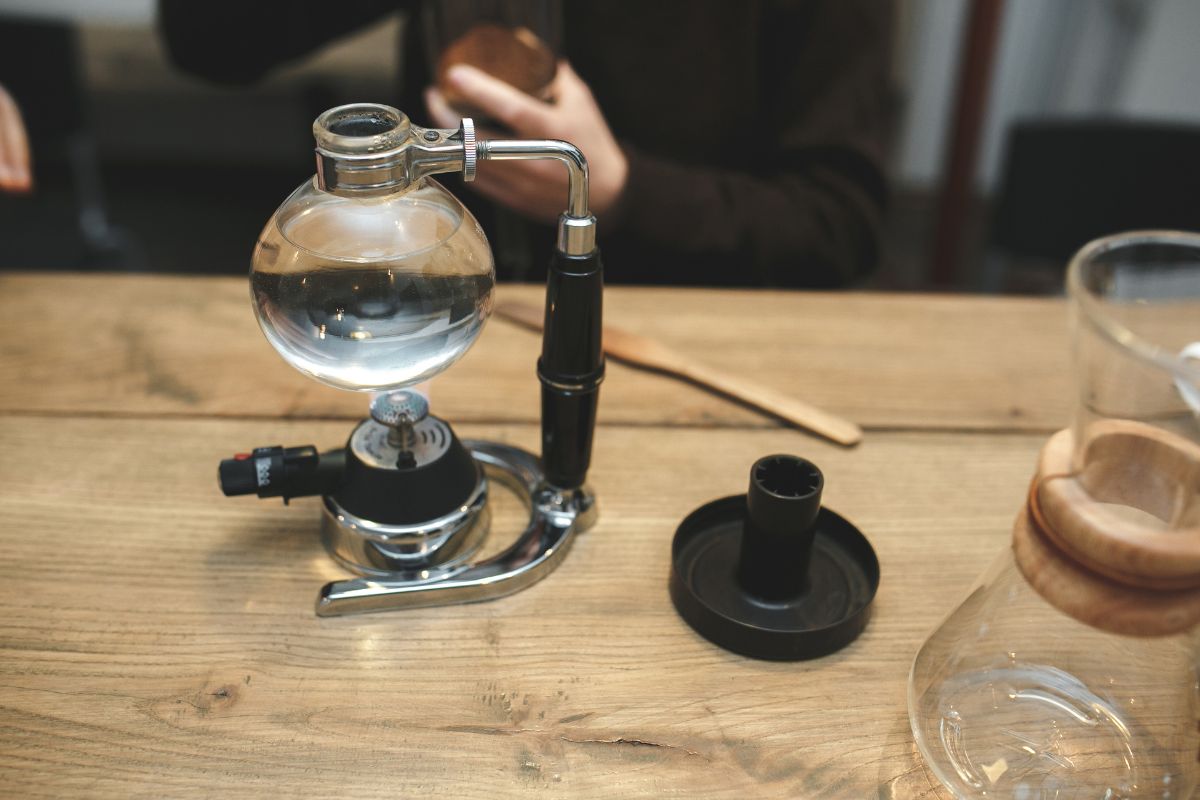
Flavored Coffee
The process is comparable to steeping tea. Simply place coarse coffee grounds in the infuser inside the carafe. Add hot water, then watch the magic happen.
You have control over the brew time with this technique. You may adjust the amount of time your coffee spends in the brew to get the perfect cup every time, whether you prefer mild or robust.
Caffeinated Coffee
Before drip coffee took over in the middle of the 1970s, percolated coffee—also one of the boiling varieties—was hugely popular.
You can make percolated coffee on a stovetop or a standalone electric cooker. Boiling water is repeatedly cycled through the grounds until it reaches the appropriate strength, often for about 7 or 8 minutes.
Types of Coffee Beans
The above-mentioned different coffee types come from various coffee beans, each with a unique taste and strength.
Robusta and Arabica are the two main variants of coffee beans sold in American supermarkets. Is there a distinction between Arabica and Robusta? You might be wondering. Oh, there is, for sure. Let’s begin straight away.
Arabica
Among the kinds of coffee beans you can find, Arabica is the most widely consumed. Depending on who you talk to, many coffee lovers prefer utilizing Arabica beans because of their rich flavor.
Arabica beans provide a richer, more nuanced flavor that you may drink directly. These coffee beans are typically the primary ingredients for black coffee. The funny thing is, although being the most common, it has less caffeine than Robusta.
Robusta
Robusta is the second most popular kind. It is more affordable and robust. Robusta is a major ingredient for espresso coffee drinks and instant coffees due to its bitter flavor. It makes the strongest coffee types.
Grab a cup of coffee made with Robusta beans if your Monday morning is dragging. Their high caffeine content will immediately awaken you!
Liberica Beans
These beans make a negligible portion of coffee in some parts of the world. It is native to West and Central Africa. Liberica coffee has a robust, fruity flavor and is quite intense and aromatic.
Excelsa Beans
Excelsa beans are a subspecies of Liberica despite producing only 7% of the world’s coffee, but its supporters want to keep it separate. It frequently appears in Arabica and Robusta house blends and has a distinctive flavor reminiscent of tart fruit.
A List of Iced Coffee Types
Although we typically think of coffee as a hot beverage, numerous delectable varieties are available in a cooled form.
Not all iced coffee is cold brewed. Instead, there’s the use of a hot brew procedure, which entails chilling before serving. Making iced coffee at home is simple; after reading some of these choices, you’ll undoubtedly want to try them.
Here are some examples of iced coffee drinks explained:
Iced Lattes and Iced Mochas
Popular coffee drinks known as iced lattes and iced mochas combine cold milk instead of steamed milk used in regular lattes and mochas.
Ca Phe Sua Da
Ca phe sua da, Vietnamese for “iced milk coffee,” is a concoction of black coffee and sweetened condensed milk poured over ice.
Eiskaffee
Iced coffee and vanilla ice cream are useful in making the German coffee beverage known as Eiskaffee.
Frappé
Greeks are the original creators of the popular iced coffee drink known as the frappe, typically served cold with whipped cream and additional ingredients such as milk, vanilla, sugar, and syrups (like caramel or chocolate).
Freddo Espresso
The Freddo Espressos production takes place in Greece during the sweltering summers using two shots of espresso and sugar. You place a few ice cubes and some espresso into a shaker. Shake the mixture for around 20 seconds. After that, pour the coffee over ice to cool it and lessen its bitterness. It is a foamy beverage.
Freddo Cappuccino
The Freddo Cappuccino, which is also well-liked in Greece, is similar to the Freddo Espresso but with the addition of cold milk foam on top.
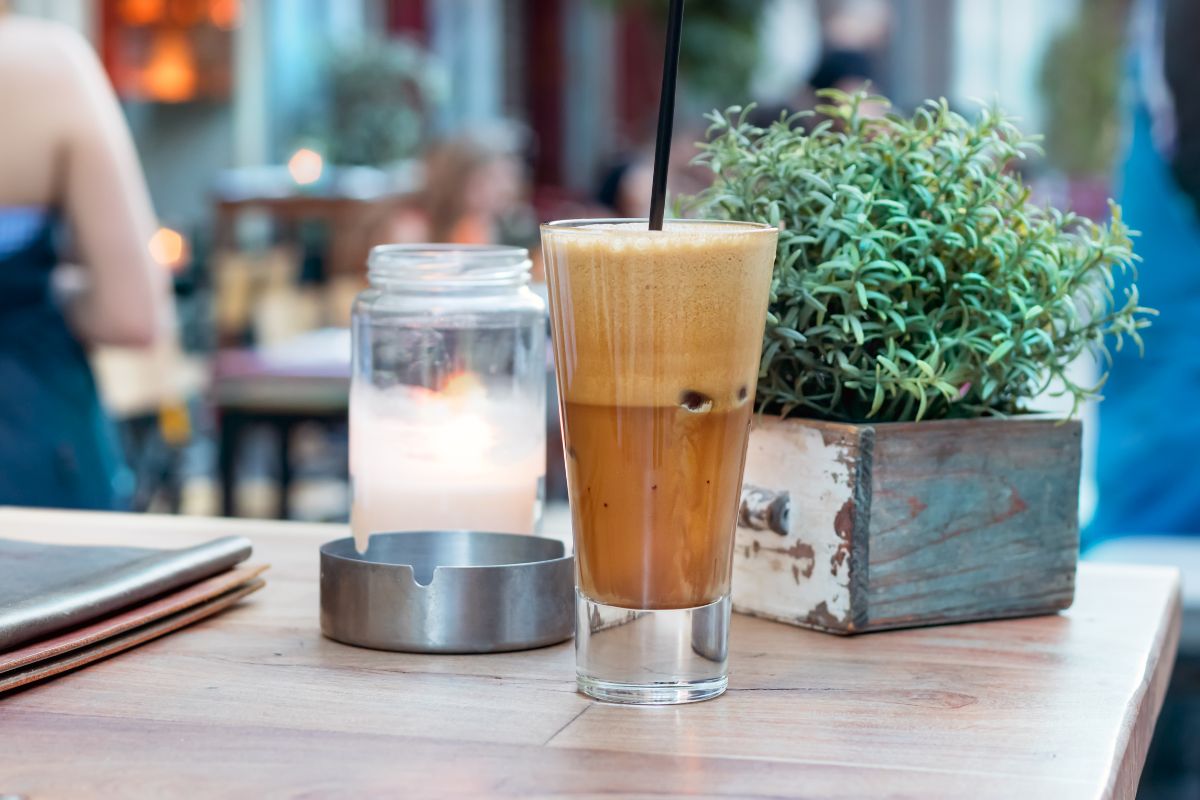
Mazagran
The mazagran originates in Algeria and is a large glassful of iced coffee. The drink might occasionally have added sugar, mint, lemon, water, or rum.
Palazzo
The Palazzo, a popular drink in Southern California, contains two espresso shots. Brew the coffee and ice, and then combine with sweetened cream.
Ice Shot
The Ice Shot originates in Australia and consists of one espresso shot served over ice in a standard latté glass. The ice dilutes the hot coffee and refrozen to a slushy consistency.
Shakerato
This Italian iced coffee beverage combines fresh espresso (one shot) and ice cubes to create a foam, much like the Freddo espresso. Pour the espresso into a martini glass after shaking.
What are the Different Types of Coffee Makers?
Coffee makers are now a must-have kitchen appliance in modern homes. Today, there are many coffee makers from different manufacturers, both traditional and contemporary. Some are manual, while others are electric.
Here are a few different types of coffee makers available in the market:
Percolator
To give your everyday brew a vintage feel, try using a percolator from the 1880s. Simply put, percolators brew coffee by forcing hot, bubbling water into the “coffee chamber,” where it steeps the coffee grains.
This cycle recurs until the coffee is ready for serving. You can use Percolators on any hot surface, including a campfire, stovetop, etc. They are commonly used for medium roasts and prepared on the stovetop.
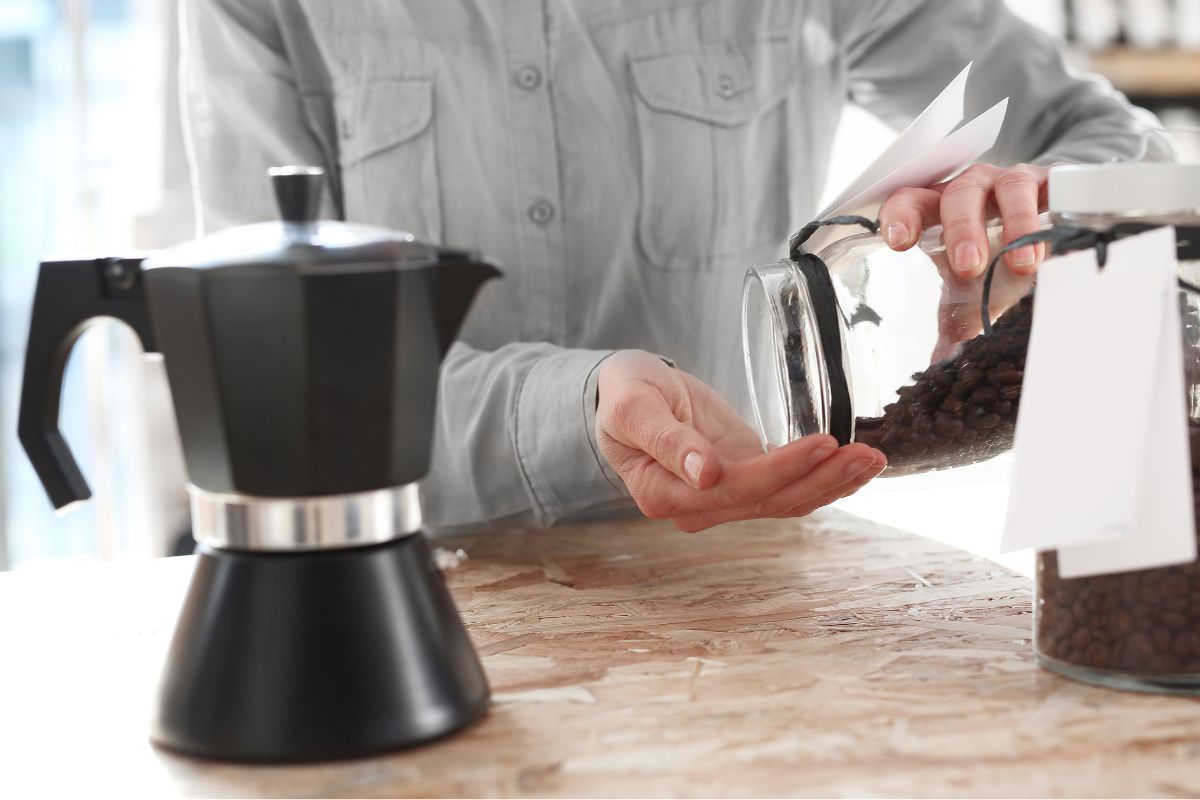
Moka Pot
There is frequent confusion between Moka pots and percolators due to their many similarities. A stovetop or a campfire might serve as both heating surfaces. The Moka pot creates a beverage similar to espresso and uses a slightly different brewing method than the percolator.
Using this manual coffee maker is simple. Pour fresh boiling water over the coffee grounds in your French press; after adding the ground coffee, let the coffee boil on low heat for a few minutes, and then press the plunger to release the coffee, just like that.
You should keep a closer check on it to prevent coffee that tastes burned; you should take the Moka pot off the heat source when the water inside runs out. In contrast, the percolator’s straightforward brewing method yields stronger coffee if it runs for a longer period.
French Press
Even though you can use any coffee bean in a French press, many people favor darker, richer roasts. How elegant does this French press appear, too? Brew up your morning beverage with style!
Use a French press to make the ideal cup of coffee. However, this cylindrical carafe, plunger, and filter can produce more than just a lovely light roast. There are lots of French press scams out there!

Pour Over
When using this coffee maker, you manually pour hot water over the beans, just as it sounds. Pour-over coffee makers like the Chemex have a good 5-star rating on Amazon.
The ability to choose the coffee’s strength and the ease of cleaning the pots are two features that fans adore. However, you require a unique, more expensive filter than a standard drip coffee filter. Some, though, you can recycle.
AeroPress
Another manual coffee maker available for you is the AeroPress. The French press and the AeroPress are very similar. This amazing little device can prepare espresso, latte cappuccino, cold brews, or a regular cup of coffee.
Drip
Drip coffee maker is a well-known and cherished vintage electric coffee maker. To start your brew in a drip coffee maker, you need to scoop your coffee, pour it into the filter, add some water, and push the start button to allow it to work its magic.
You will soon hear the lovely sounds of your coffee dropping directly into your coffee pot. Some drip coffee makers have a thermal carafe.
Thermal carafes keep your coffee tasting fresh and hot for longer than most glass carafes. They typically have a double-layered, stainless steel wall. While most drip coffee makers use glass carafes, some also use thermal carafes.
Cold Brew
Cold brew coffee makers might be a good investment for ardent consumers of the beverage. Pour your coffee grinds into a cold brew coffee maker, let it brew, and then serve.
You can preserve this coffee for up to 36 hours. If you’re searching for a multipurpose coffee maker, you can prepare cold brew coffee on other devices, such as AeroPress.
Single Serve
Single-serve coffee makers are some of the most sold-out coffee makers in the world because of their convenience and ease of use.
To use your single-serve coffee maker, pour water into the reusable filter after measuring out the proper amount of coffee, and presto! Soon, a special cup of coffee will be ready for you. Single-serve coffee makers are suitable for single-person households (or those where just one person drinks coffee).
Siphon Coffee Makers
Siphon coffee makers, also known as suction pot coffee makers, might not be the most practical appliances for regular use because of their numerous fragile parts and unusually long brewing times.
Many siphon pot users vouch for the remarkably delicious coffee they create. The siphon pot works well as a spectacle while hosting guests and serving coffee. They produce flavorful coffee.
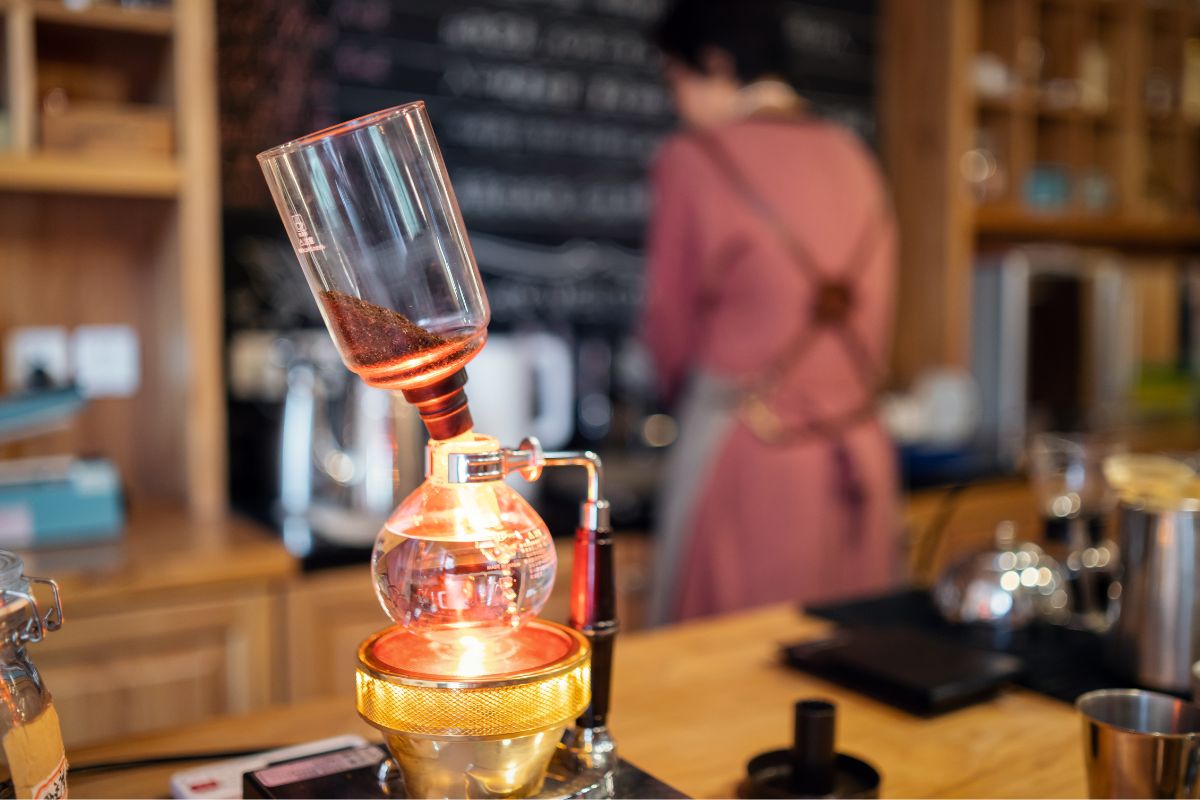
Kinds of Espresso Drinks
In most cases, espresso often makes a base for most coffee drinks. However, remember that different baristas can use varying milk ratios, so the taste might slightly differ. Let’s look at the kinds of espresso drinks below:
- Antoccino – A single espresso shot mixed 1:1 with heated milk.
- Macchiato – A shot of espresso with a little steamed or foamed milk (only about two teaspoons).
- Cappuccino – It consists of 1/3 espresso, 1/3 steamed milk foam, and 1/3 hot milk.
- Flat White – It consists of 2/3 heated milk and 1/3 espresso.
- Cafe Bombon – Is native to Spain and blended 1:1 espresso with sweetened condensed milk.
- Latte – you make this with a thin coating of milk foam, 1/3 heated milk, and 2/3 espresso.
- Galao – This espresso-based beverage is native to Portugal. It contains espresso with foamed milk served in a tall glass.
- Caffe Gommosa – It is a single espresso shot mixed with marshmallows.
- Cortado – Espresso combined with an equal amount of steamed milk to lessen its acidity.
- Americano – A single or double shot of espresso mixed with hot water. It makes a coffee beverage stronger than conventional drip coffee but has a different flavor.
- Long Black – An inverted version of the Americano. It is typically a 6-ounce (0.177 liters) beverage in which the entire amount of water passes through the espresso maker rather than placed on top.
- Cafe Cubano – As the name suggests, you sweeten this espresso beverage with demerara sugar. It originates from Cuba.
- Cafe Zorro – Comprises a 1:1 ratio of water and two espresso shots (0.06 liters each).
- Doppio – A demitasse-cup-sized double shot of espresso ( a small, single-serve cup).
- Espresso Romano: An espresso shot served with a slice of lemon.
- Guillermo – It’s two espresso shots with ice or lime wedges on top.
- Ristretto – is a concentrated espresso brewed with the same quantity of coffee as a regular espresso shot but with just half as much water.
Combination Coffee Drinks
These coffee drinks start with an ordinary cup of coffee combined with espresso.
Coffee au Lait
It is also known as “coffee with milk.” It combines steaming milk with robust coffee in a 1:1 ratio.
Coffee with Espresso
Also known as the “eye-opener” or “shot in the dark.” This coffee drink combines espresso with normal coffee to either boost the flavor or the amount of caffeine.
Black Eye
It is a standard coffee cup with two espresso shots.
Dead Eye
It combines three shots of espresso added to a standard coffee.
Botz
Also known as “mud,” this coffee is one of the most popular in Israel. It involves adding scalding hot water to finely ground Turkish coffee, letting the mixture cool, and then letting the grounds sink to the bottom. Typically, it’s a blend of cardamom and sugar.
Nitro Coffee
Nitrogen-infused coffee. Rich and frothy, this cold brew coffee beverage doesn’t need any additional sugar and has a naturally sweet flavor from the tiny bubbles.
Bulletproof Coffee
This coffee consists of 100% pure caprylic acid triglyceride extracted from highly refined coconut oil, unsalted grass-fed butter, and “Brain Octane Oil.” It’s mixed to resemble a foamy latte in consistency.
Types of Coffee Beverages With Tea
There are numerous coffee and tea combinations all over the world. Here are some of the most loved coffee with tea combos:
Black tie
You get it by mixing a double shot of espresso (or strong coffee) with vintage Thai iced tea (a mixture of black tea, condensed milk or cream, and some spices).
Red tie
A similar beverage to black tie made with just one espresso shot as opposed to two.
Dirty Chai Latte
It is a drink that combines a standard coffee latte with chai spiced tea.
Yuenyeung Drink
You prepare this popular Hong Kong beverage by fusing coffee and milk tea made in that city.
Coffee Drinks With Alcohol
There are far too many coffee/alcohol beverages in existence for me to list them all, but here are a few notable ones:
Carajillo
Carajillo is a Spanish beverage made with rum, whiskey, brandy, or anisette with coffee. The American variation consists of coffee and alcohol combined in a mug with a sugar rim flamed to caramelize the sugar. You will find a layer of whipped cream at the top.
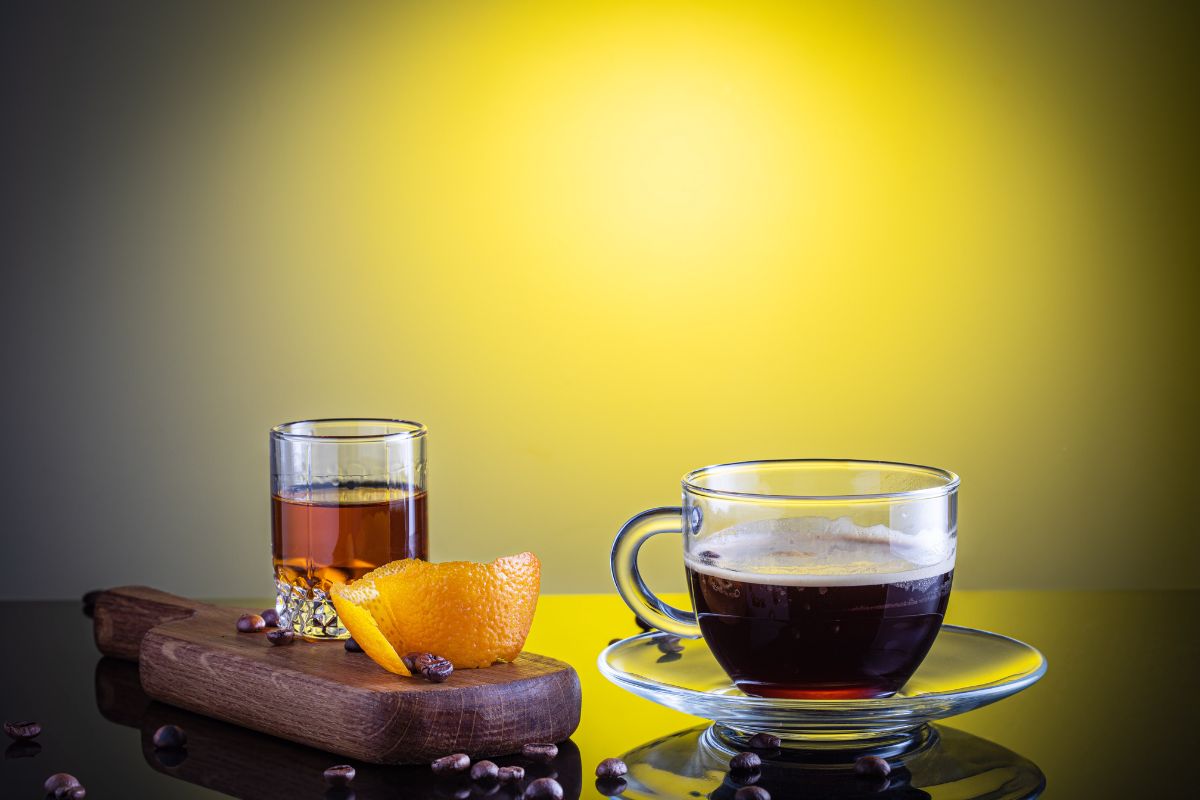
Pharisee
Made with black coffee, whipped cream, and a double shot of rum, this traditional beverage from Nordstrand, Germany, is well-served in a mug.
Bailey’s Irish Cream and Coffee
Coffee with a shot of Baileys Irish Cream liqueur 0.84 fluid ounces (0.025 liters) with whipped cream at the top makes up this beverage, served in a clear liqueur coffee glass.
Rüdesheimer Kaffee
The Rüdesheimer Kaffee is a German beverage made of coffee, sugar, and Asbach Uralt brandy topped with whipped cream.
Caffè Corretto
An Italian beverage made by “correcting” a shot of espresso with a shot of booze (usually brandy, grappa, sambuca.)
Barraquito
The traditional beverage known as a “barracuda” is a Tenerife native (one of the Canary Islands). It combines Licor 43, espresso, foamed milk, condensed sweetened milk, cinnamon, and lemon.
Irish Coffee
Irish coffee is a beverage made with coffee, whiskey, cream, and occasionally sugar.
A List of Flavored Coffees
Look over these flavors of coffee drinks to see which ones are familiar to you.
- Café Miel – Steamed milk, cinnamon, nutmeg, vanilla, and honey are the main ingredients in the coffee beverage known as a “café miel,” derived from the French word for honey.
- Melya – A coffee beverage with honey and cocoa powder as flavorings (sometimes cream).
- Espresso – This is Espresso combined with heated milk and chocolate powder. Before adding the espresso, cocoa powder, and steamed milk, some people line their glasses with Nutella.
- Caffè Marocchino – It comprises espresso, cocoa powder, and milk foam. This beverage is comparable to an espresso.
- Affogato – you pour a shot of espresso on top of a scoop of ice cream (or gelato). You can also use this Italian beverage as a dessert. On rare occasions, you may add liqueur to the espresso. A white affogato, a regular affogato with milk added, is also an option.
- Mocha or Mochaccino -It is a double espresso shot of 2.02 fluid ounces (60 milliliters) with steamed milk, hot chocolate (or chocolate syrup or cocoa powder), and whipped cream in a cappuccino cup.
- Caffè Medici – Despite having an Italian name, this coffee beverage is famous in Seattle coffee shops. The Caffè Medici is a doppio (two shots of espresso in a single cup), served with whipped cream on top and topped with an orange peel and chocolate syrup.
- Cafe Borgia – This is mocha with cinnamon, whipped cream, and orange rind (or occasionally orange flavoring).
- Café de olla – Coffee made in earthen clay pots traditionally served in Latin America and spiced with cinnamon and piloncillo (also known as panela, cane sugar).
- Café Rápido y Sucio – is also known as “quick and dirty coffee.” This coffee beverage consists of just about three shots of espresso and chocolate syrup (no water or milk).
- Coffee with a flavor shot – Several flavored syrups, such as French vanilla, hazelnut, Irish cream (non-alcoholic), caramel, and chocolate, are frequently added to coffee.
- Vienna Coffee – This is an alcoholic beverage made with regular or espresso coffee, thick cream or whipped cream, and cocoa powder.
- Kopi Susu – It is a coffee-and-sweetened condensed-milk concoction allowed to cool while the coffee grounds sink to the bottom.
- Egg coffee – Robusta coffee, sugar, condensed milk, and egg yolk are the main ingredients in egg coffee, a popular beverage in Vietnam.
A List of Coffee Roast Types
The kind of coffee beans you use and how you roast them affects the flavor of your coffee. Coffee beans become darker in color and release more taste and aroma as they roast for longer. On the other hand, the amount of acidity and caffeine in a roast decreases over time. The different levels of light, medium, medium-dark, and dark coffee bean roasts are as below:
Light Roast
Compared to other roasts, light roast coffee takes the shortest time to roast (other than white coffee). As a result, the coffee’s surface isn’t oily and has a more golden brown shade. Names for light roast coffees include Half City, New England, and Cinnamon Roast.
Medium Roast
The color of medium roast coffee is usually medium brown; in the United States, it is the most consumed roast. The darker roasts have an oily surface, but this one does not. Examples of medium roast coffees are American, Regular, and Breakfast.
White Roast
These coffees have the lightest roast. White coffee doesn’t taste like regular coffee due to its distinct flavor.
Dark Roast
Many coffee drinkers favor dark roasts because of their additional bold body and weighty mouthfeel, especially those in Europe.
These coffee beans undergo the most extensive roasting, reaching dark chocolate or almost black color. This process releases the oil from the bean, which is visible in the brew. High, Espresso, European, Dark, and Italian are a few examples of well-known dark roast names.
Medium-Dark Roast
Roasted coffee beans with a medium-dark hue have a robust body, a rich flavor, and a bittersweet aftertaste. They have a richer scent, a less acidic surface, and a semi-oily surface. Medium-dark roasts are frequently referred to as Full City, After Dinner, Light Espresso, and Light French.
Animal Poop Coffees
Do you know what cat poop coffee is? What about Black Ivory or Jacu Bird Coffee? Look at these odd poop coffees:
Kopi Luwak Coffee (Civet Coffee)
The Asian palm civet, a furry, nocturnal mammal native to Southeast Asia and Sub-Saharan Africa, inspired the name of this coffee. Cherry coffee is a favorite food of the civet. After collecting these excretions, separate the coffee beans, clean, and roast before brewing into one of the priciest varieties of coffee.
Black Ivory Coffee
At the Golden Triangle Asian Elephant Foundation sanctuary in Chiang Saen, Thailand, rescued elephants make Black Ivory Coffee. The elephants consume copious amounts of coffee beans, which they then excrete. Gather the beans and prepare them for consumption after processing.
Jacu Bird Coffee
The Jacu bird variant is a native of Brazilian coffee and, like the civet, eats ripe coffee cherries. Before processing, workers gather the bird’s droppings. People who have consumed this coffee have praised its full-bodied sweetness, cinnamon taste, and smooth, clean finish.
Other Types of Coffee
We next discuss instant and decaf coffee before looking at a few other intriguing varieties of coffee drinks that might not be familiar to you. If you have tried any or know of any that we haven’t featured here, do let us know in a comment.
Instant Coffee
You can use previously brewed ground coffee beans to make instant coffee. This coffee is often in the form of powder or granules. You can rehydrate it with hot or cold water (iced coffee) for an “instant” cup.
Different people use different procedures to achieve this. Some coffee companies produce instant coffee as a concentrated liquid. Some of these well-known instant coffee brands may be familiar to you:
- Folgers
- Maxwell House
- Nescafé
- Kenco
- Mr. Brown Coffee
- Sanka
- UCC
- Chock full o’Nuts
- Moccona
- Coffee without caffeine (Decaffeinated Coffee)
- Decaffeinated coffee (also known as decaf) has little to no caffeine (usually 97% to 99.9% caffeine-free).
Although many people enjoy the flavor of coffee, they do not desire caffeine. While drinking coffee with caffeine has some benefits, such as keeping you alert, there are also health risks associated with excessive caffeine use, such as jitteriness and a rapid heartbeat.
Caffeine removal from coffee involves several different methods. In most procedures, you soak the coffee beans in water or put them through a solvent to dissolve the caffeine.
Canned Coffee
While ground coffee is mostly available in huge cans, canned coffee refers to coffee that is readily brewed and ready for consumption. Canned coffee is available worldwide in supermarkets, convenience stores, and vending machines.
Coffee Milk
You can use coffee to produce chocolate milk by mixing it with milk and adding chocolate syrup. You can add Coffee syrup, a product of sweetened coffee concentrate, to milk to create coffee milk in place of chocolate syrup.
South Indian Coffee
Indian filter coffee, Mysore filter coffee, and Kaapi are other names for south Indian coffee. These dark-roasted coffee beans make this sweet, milky coffee beverage popular in South India.
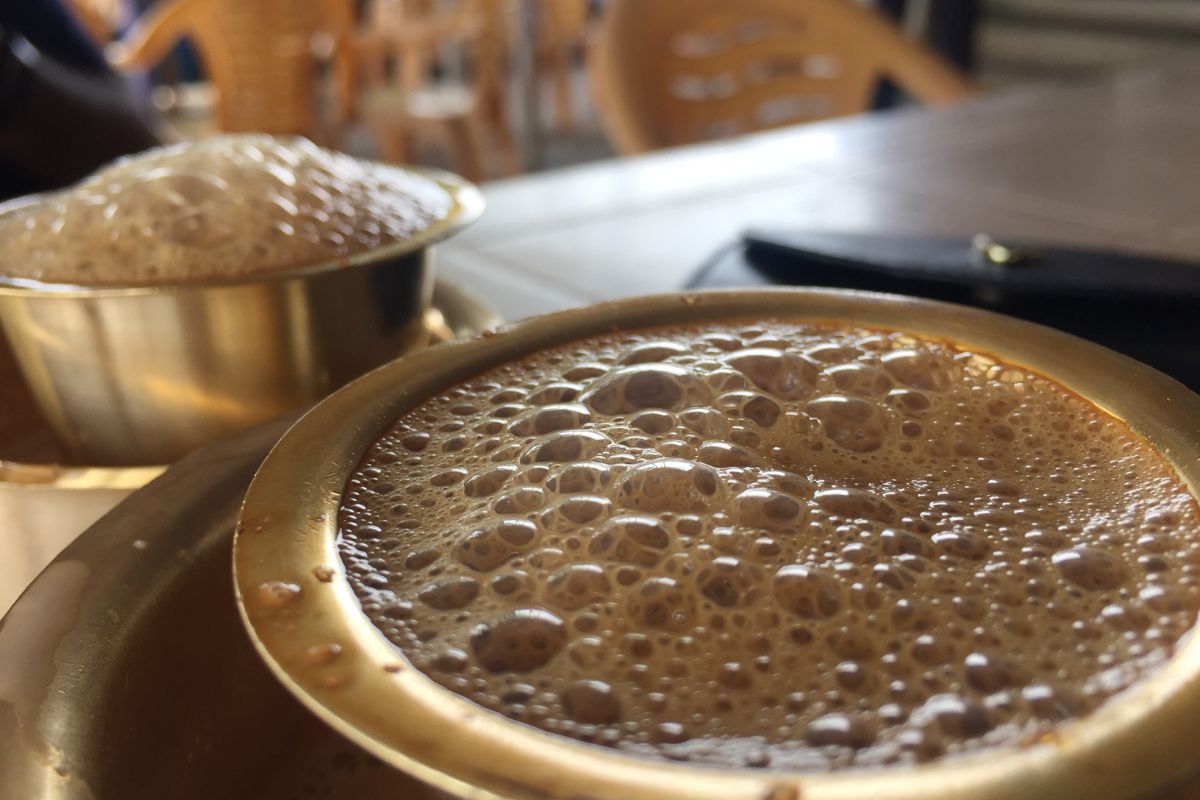
Pocillo
Pocillo is frequently used to describe “a tiny bit of coffee” or coffee served in a smaller-than-normal coffee cup; the Pocillo is a popular after-dinner beverage in Latin American nations.
It can involve any coffee beverage, but most frequently, it consists of a shot or a tiny amount of unsweetened coffee made in an espresso or Moka pot.
The Bottom Line
Coffee is among the most loved drinks across the world and a versatile drink. As a coffee lover, you may not be able to master all names of coffee drinks available. The best thing to do is to try out most of them, if not all, and pick a favorite type.
There is no limitation to the potential coffee flavor combination; you can still explore and experiment with the amazing world of coffee drinks.
We hope this guide has ignited a craving for coffee or made you feel you should probably try a different brewing method or coffee combination. Let us know in the comment section below which one is your favorite.

